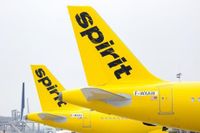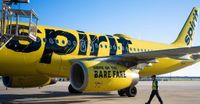Spirit Airlines, the vibrant yellow staple of America’s skies and one of the country’s most recognizable ultra-low-cost carriers, has filed for Chapter 11 bankruptcy protection for the second time in less than a year. The announcement, made on August 29, 2025, sent ripples through the aviation industry and left travelers, employees, and investors bracing for what comes next. For a company that once prided itself on shaking up the market with rock-bottom fares, this latest move marks a pivotal—if precarious—moment in its decades-long journey.
According to CNN, the Florida-based carrier’s decision comes after months of mounting losses, dwindling cash reserves, and a failed attempt to reinvent itself as a more premium airline. Spirit had only recently emerged from its first bankruptcy in March 2025, having restructured some of its debts, secured a $350 million equity investment, and appointed a new CEO, Dave Davis. But these efforts, it turns out, were not enough to stem the tide of financial troubles. In the second quarter of 2025, the airline posted an operational loss of $184 million and a net loss of $245 million—worse than the same period last year, when those figures stood at $152 million and $192 million, respectively (Reuters).
Spirit’s struggles have been no secret. Earlier this month, the company warned in a Securities and Exchange Commission (SEC) filing that its ability to continue as a going concern was in doubt unless its cash position improved. The airline had already borrowed the entire $275 million available under its revolving credit facility in August, a clear sign of its cash crunch (Reuters).
Despite the bankruptcy filing, Spirit insists that flights, ticket sales, bookings, and core operations will continue as normal. In a public statement, CEO Dave Davis reassured customers and investors: “Since emerging from our previous restructuring, which was targeted exclusively on reducing Spirit’s funded debt and raising equity capital, it has become clear that there is much more work to be done and many more tools are available to best position Spirit for the future.”
Spirit’s financial woes are rooted in a combination of industry headwinds and company-specific missteps. The airline, which began in 1964 as a long-haul freight carrier before shifting to passenger aviation in the 1980s under the Charter One Airlines banner, built its brand as a discount carrier in 1992. For years, it attracted price-conscious travelers willing to forgo extras like checked bags and seat assignments in exchange for ultra-low fares. But as the pandemic reshaped consumer priorities, demand shifted toward more comfortable, experience-driven travel. Ultra-low-cost carriers like Spirit found themselves in a bind, struggling to adapt their business models to a new reality (CNN).
Spirit’s attempts to pivot have been fraught with challenges. The company had tried to reinvent itself as a more premium airline to tap into post-pandemic travel trends, but uncertainty caused by tariffs under the Trump administration and budget cuts cooled consumer spending and drove down domestic ticket prices. The collapse of a $3.8 billion merger with JetBlue Airways in 2024, coupled with engine issues from RTX’s Pratt & Whitney that forced the grounding of part of Spirit’s Airbus fleet, only compounded the airline’s troubles. Last year alone, Spirit posted a net loss of about $1.2 billion (The Street).
The financial pain has been felt across the board. Spirit’s stock plummeted by more than 45% in after-hours trading on August 29, 2025, and further declined by 1.21% the following day, reaching just $1.22 per share—a dramatic fall from $8.28 in May 2025. The company had already been delisted from the New York Stock Exchange during its first bankruptcy and now trades over-the-counter, with privatization likely on the horizon.
To address its cost structure, Spirit’s management has implemented a series of tough measures. Over 400 pilots have been furloughed or demoted, and the airline has replaced its longstanding base fare model with a new system of tiered fare classes offering more benefits. These moves, however, have yet to restore profitability. In fact, Spirit’s total operating expenses in the latest quarter were $1.2 billion—amounting to a staggering 118% of its quarterly revenue (Reuters).
The impact of Spirit’s turmoil is not limited to its own balance sheet. As the airline considers reducing its presence in certain markets and cutting its fleet to lower debt and lease obligations, opportunities are emerging for competitors. Frontier Airlines, which had previously attempted to acquire Spirit, launched 20 new routes targeting key Spirit markets in July 2025. Analysts suggest that other carriers, such as Southwest and United Airlines, may also be eyeing Spirit’s aircraft and assets as the company restructures (Reuters).
Spirit’s struggles have also prompted concern among employees. Union representatives have warned flight attendants to “prepare for all possible scenarios,” and the company has set up a dedicated website to keep customers and investors informed about the restructuring process. Despite the uncertainty, Spirit has pledged to continue paying wages and benefits to its employees and to honor obligations to vendors and suppliers throughout the bankruptcy proceedings (The Street).
The challenges facing Spirit Airlines are emblematic of broader shifts in the U.S. aviation sector. The ultra-low-cost model, once celebrated for democratizing air travel and putting pressure on fares industry-wide, is now under intense scrutiny. The pandemic, changing consumer tastes, and economic pressures have forced carriers to rethink their value propositions. For Spirit, the road ahead will require not only financial restructuring but also a fundamental reimagining of its place in the market.
Industry watchers are keeping a close eye on Spirit’s next moves. The company has indicated that it will work with lessors, bondholders, and other stakeholders to address its cost structure, redesign its network, and resize its fleet. The outcome of these efforts will shape not only Spirit’s future but also the competitive landscape of U.S. air travel. As CEO Dave Davis put it, “Spirit is a critical part of the U.S. aviation industry. We have saved consumers hundreds of millions of dollars, whether they fly with us or not.”
For travelers, investors, and employees alike, Spirit’s saga is a stark reminder of the volatility that can define even the most familiar names in the skies. The coming months will reveal whether the airline can truly reinvent itself—or if, after decades of turbulence, its storied run is nearing its final descent.

